 |
Dr. Stuart Parkin is an IBM Fellow and Manager of the Magnetoelectronics group at the IBM Almaden Research Center, San Jose, California and a consulting professor in the Department of Applied Physics at Stanford University.
Courtesy of IBM |
| |
Highlights:
• IBM Research is the first to measure the movement and processing of digital data as a magnetic pattern on nanowires 1,000 times finer than a human hair.
• New memory uses the spin of electrons to move data at hundreds of miles per hour to atomically precise positions along the nanowire racetrack.
• This memory could someday enable a single portable device to store all the movies produced worldwide in a given year and run on a single battery for weeks at a time.
 |
The IBM Almaden Research Center in San Jose.
Courtesy of IBM / YouTube |
| |
San Jose, Calif., USA - December 23, 2010
IBM (NYSE: IBM)
Researchers today revealed a previously unknown aspect of
key physics inside Racetrack memory - a new technology design which stands to improve
memory capabilities within mobile phones, laptop computers and
business-class servers.
This
new class of memory could enable devices to store much more information - as much as a factor of
100 times greater - while using much less energy than today's designs.
The Racetrack memory project - which started in
IBM's Research labs only six years ago - flips the current memory paradigm on its head.
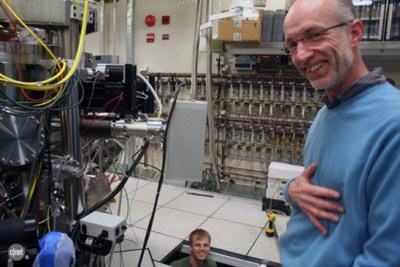 |
Dr. Stuart Parkin (standing), one of the reigning celebrities in thin film magnetic research. His work on thin magnetic film structures allowed IBM, among others, to exploit the giant magnetoresistive effect to significantly boost the density of hard drives.
Courtesy of IBM |
| |
Instead of making computers seek out the data it needs – as is the case in traditional computing systems –
IBM’s Racetrack memory automatically moves data to where it can be used, sliding magnetic bits back and forth along nanowire "
racetracks."
This technique would allow electronic manufacturers to design a portable device capable of storing all the movies produced worldwide in a given year with room to spare.
Digital data is typically stored in
magnetic hard disk drives, which are low-cost but slow due to their moving parts, or in solid state memory such as
Flash memory, which are faster but more expensive.
Racetrack memory aims to combine the best attributes of these two types of devices by storing data as magnetic regions – also called domains – in
racetracks just a
few tens of nanometers wide.
The new understanding, revealed today in
the journal Science, allows the precise control of the placement of these domains, which the
IBM team has proven can act as nano-sized data keepers that can not only store at least
100 times more memory than today's techniques, but can be accessed at
much greater speeds.
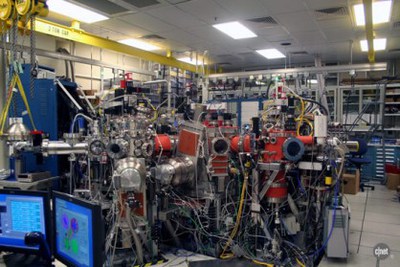 |
Parkin's research microscope.
Courtesy of IBM |
| |
By controlling electrical pulses in the device, the scientists can move these domain walls at speeds of hundreds of miles per hour and then stop them precisely at the position needed - allowing massive amounts of stored information to be accessed in
less than a billionth of a second.
The full scientific details of the discovery can be read in the scientific paper.
In short, the
IBM scientists were the first to measure the time and distance of domain wall acceleration and deceleration in response to electric current pulses, which is how digital information is moved and processed in
Racetrack memory.
This not only gives scientists an unprecedented understanding and control over the magnetic movements inside these devices but also
advances IBM’s Racetrack memory - driving it closer to marketplace viability.
 |
Dr. Stuart Parkin, an IBM Fellow at IBM Research – Almaden.
Courtesy of IBM |
| |
“We discovered that domain walls don't hit peak acceleration as soon as the current is turned on, and that it takes them exactly the same time and distance to hit peak acceleration as it does to decelerate and eventually come to a stop,” said
Dr. Stuart Parkin, an IBM Fellow at IBM Research – Almaden.
“This was previously undiscovered in part because it was not clear whether the domain walls actually had mass, and how the effects of acceleration and deceleration could exactly compensate one another. Now we know domain walls can be positioned precisely along the racetracks simply by varying the length of the current pulses even though the walls have mass”.
To achieve the densest and fastest possible memory, the domain walls inside the device must be moved at speeds of hundreds of miles per hour to atomically precise positions along the tracks.
These
timescales (tens of nanoseconds) and
distances (micrometers) are surprisingly long, especially since previous experiments had shown no evidence for acceleration and deceleration for domain walls driven along
smooth racetracks with current.
A closer look at Racetrack
For nearly fifty years, scientists have explored the possibility of storing information in magnetic domain walls, which are the boundaries between magnetic regions or "domains" in magnetic materials.
Until now, manipulating domain walls was expensive, complex and used significant power to generate the fields necessary to do so.
In a proof of
concept paper in 2008 (Hayashi, M., Thomas, L., Moriya, R., Rettner, C. & Parkin, S. S. P. Current-Controlled Magnetic Domain-Wall Nanowire Shift Register. Science 320, 209-211)
IBM researchers were the first to demonstrate the potential of Racetrack memory, showing how the use of spin momentum considerably simplifies the memory device.
 |
IBM researcher Stuart Parkin has a reason to celebrate receiving the Daniel E. Noble Award from the IEEE in May 2008 for his work on random access memory (RAM). His innovations helped open the door to today’s hard disk drive industry – and are found in nearly every disk drive now in use.
Courtesy of IBM |
| |
The details and results of this research effort will be reported
in the December 24, 2010 issue of Science.
The paper is titled, “
Dynamics of magnetic domain walls under their own inertia,” and is authored
by Luc Thomas, Rai Moriya, Charles Rettner and Stuart Parkin of IBM Research – Almaden.
For more information about
Racetrack Memory, please visit:
http://www.almaden.ibm.com/spinaps/research/sd/?racetrack
Contact(s) information
Ari Entin
IBM Media Relations
408-927-2272
aentin@us.ibm.com
SOURCE: IBM
http://www-03.ibm.com/press/us/en/pressrelease/33291.wss
Spintronics Devices Research
Racetrack Memory, Spin Injectors, Magnetic Tunnel Transistors, and a host of more exotic spintronic designs take us beyond the realm of the simple
GMR spinvalve.
Magnetic Racetrack Memory Project
Today digital data is stored in two main types of devices, magnetic hard disk drives, and solid state random access memories.
The former stores data very cheaply but, since it relies on the mechanical rotation of a disk, is slow and somewhat unreliable.
The latter allows rapid access to data but the cost is about 100 times higher per bit than a magnetic disk drive.
At Almaden we are working on a radically new storage-memory technology based on recently discovered spintronic phenomena.
One of these is a means of using spin currents to directly manipulate the magnetic state of nano-scale magnetic regions – magnetic domain walls – within
magnetic nano-wires.
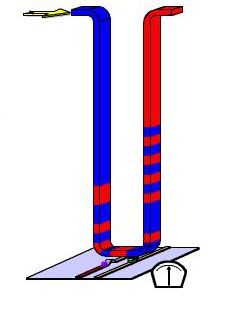 |
Racetrack Memory, Spin Injectors, Magnetic Tunnel Transistors, and a host of more exotic spintronic designs take us beyond the realm of the simple GMR spinvalve.
Courtesy of IBM |
| |
This device, the
magnetic race-track, is a powerful storage-class memory which promises a solid state memory with the cost and storage capacities rivaling that of
magnetic disk drives but with much improved performance and reliability.
This could provide
another revolution in our ability to access and manipulate digital information.
SOURCE: IBM
http://www.almaden.ibm.com/spinaps/research/sd/?racetrack
IBM-Stanford Spintronic Science and Applications Center
The IBM-Stanford Spintronic Science and Applications Center (SpinAps) was established in 2004 to foster a unique understanding of and experimental capabilities in magnetism and magnetic materials, combining the experience and expertise in metal-insulator heterostructures at the
IBM Almaden Research Center with the theoretical and experimental work in
semiconductors at
Stanford University.
 |
|
IBM-Stanford Spintronic Science and Applications Center Scientists
|
| |
This dynamic
collaboration between Almaden scientists and engineers, Stanford faculty, and
students and post-doctoral fellows working at both facilities aims to both elucidate the theoretical and practical fundamentals of the emergent field of spintronics and develop disruptive advanced technology built on those fundamentals.
What is spintronics?
The word “spintronics” (short for “spin electronics”) refers to devices that take advantage of electrons' quantum property called “
spin.”
Electrons don't actually spin around an axis, although in many ways they may behave as if they do. More familiar is the electron's quantum property of “
negative charge”: Moving charge creates electrical current.
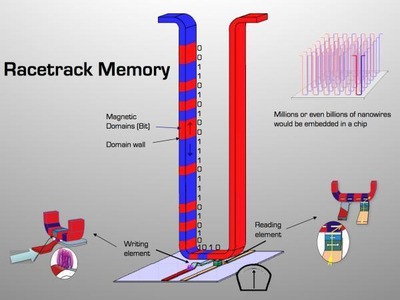 |
Racetrack Memory.
Courtesy of IBM |
| |
Electron spin has two possible states, either “up” or “down.”
Aligning spins in a material creates
magnetism.
Moreover, magnetic fields affect the passage of “
up” and “
down” electrons differently.
Under normal conditions, the spins of conducting electrons are roughly
half-up and
half-down.
Controlling the spin of electrons within a device can produce surprising and substantial changes in its properties.
A new generation of devices based upon the manipulation of spins in solids may have entirely new functionality that could provide a foundation for entirely new computational paradigms.
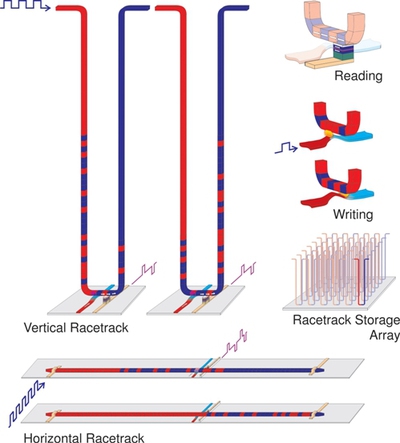 |
IBM scientists unveiled a major breakthrough in their effort to build a new class of memory, nicknamed "racetrack." A diagram of the nanowire shows how an electric current is used to slide - or "race" - tiny magnetic patterns around the nanowire "track," where the device can read and write data in less than a nanosecond. The racetrack memory would stand billions of nanowires, like the one diagrammed here, around the edge of a chip, and potentially allow for hundreds of times the amount of storage in the same space as today's memory.
Courtesy of IBM |
| |
For example, the first widely used spintronic device -- the
Giant Magnetoresistive (GMR) spin-valve head for magnetic hard-disk drives - exhibits large changes in electrical resistance due to variations in the relative magnetic orientation of layers on either side of a spacer layer only 2-3 atoms thick.
When the orientations are in the same direction (“
parallel”), electrons with one type of spin pass freely while those with the opposite spin meet greater resistance.
When the magnetic orientations are in opposite directions (“
antiparallel”), all the electrons meet resistance, resulting in a high overall electrical resistance through the
head.
By designing the structure so a faint external magnetic field would change the relative magnetic orientations of the key layers, the
GMR head became an extraordinarily sensitive
magnetic-field sensor.
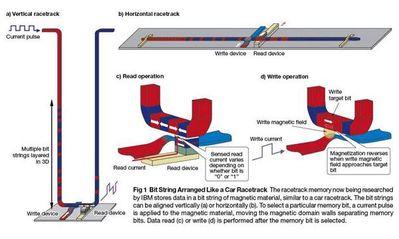 |
Bit String Arranged Like a Car Racetrack.
Courtesy of IBM |
| |
Pioneered by IBM in 1997, the GMR head enabled hard-disk drives to read smaller data bits, which led to a more than
40-fold increase in data-storage density over the past seven years.
Spintronic structures are also at the
heart of Magnetic Random Access Memory (MRAM), a fast non-volatile memory concept originally proposed by
IBM and currently being developed by
IBM, Infineon and others.
SOURCE: IBM
http://www.almaden.ibm.com/spinaps/
Video
IBM Introduces Racetrack Memory Concept
http://www.youtube.com/watch?v=zIjK1dMdTGY&feature=related
Dr. Stuart Parkin
IBM Fellow Manager, Magnetoelectronics, Almaden Research Center, IBM Research
 |
Dr. Stuart Parkin
Courtesy of IBM |
| |
Stuart Parkin is an IBM Fellow and Manager of the Magnetoelectronics group at the IBM Almaden Research Center, San Jose, California and a consulting professor in the Department of Applied Physics at Stanford University.
He is also director of the IBM-Stanford Spintronic Science and Applications Center, which was formed in 2004.
He received his BA and PhD degrees from the University of Cambridge and joined IBM as a postdoctoral fellow in 1982, becoming a permanent member of the staff the following year.
In 1999 he was named an IBM Fellow, IBM's highest technical honor.
Parkin's research interests have included organic superconductors, high-temperature superconductors, and, most recently, magnetic thin film structures and spintronic materials and devices for advanced sensor, memory, and logic applications.
He is a Fellow of the Royal Society, the American Physical Society, the Institute of Physics (London), the Institute of Electrical and Electronics Engineers, and the American Association for the Advancement of Science.
Parkin is the recipient of numerous honors, including a Humboldt Research Award (2004), the 1999-2000 American Institute of Physics Prize for Industrial Applications of Physics, the European Physical Society's Hewlett- Packard Europhysics Prize (1997), the American Physical Society's International New Materials Prize (1994), the MRS Outstanding Young Investigator Award (1991) and the Charles Vernon Boys Prize from the Institute of Physics, London (1991).
In 2001, he was named R&D Magazine's first Innovator of the Year.
Parkin has authored ~350 papers and has ~54 issued patents.
Parkin is a pioneer in the science and application of spintronic materials.
His discovery of oscillatory interlayer coupling in magnetic multilayers and giant magnetoresistance in sputter deposited magnetic metallic heterostructures in 1989 led to IBM's development of the spin-valve read head, which enabled a more than 100-fold increase in the magnetic hard-disk-drive data-density since 1998.
Dr. Parkin also proposed using magnetic tunneling junction storage elements to create a high performance magnetic random access memory in 1995.
MRAM memory promises unique attributes of high speed, high density and non-volatility.
The development by Dr. Parkin in 2001 of giant tunneling magnetoresistance in magnetic tunnel junctions using highly textured MgO tunnel barriers has made MRAM even more promising.
IBM developed the first MRAM prototype in 1999 and is currently developing a 16 Mbit chip.
Parkin is currently researching new structures for use as spin transistors and spin-logic devices that may enable a new generation of low-power electronics.
SOURCE: IBM
http://www.almaden.ibm.com/spinaps/scientists/index.shtml?parkin
ASTROMAN magazine

